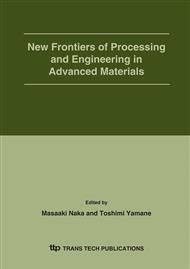p.425
p.431
p.437
p.443
p.449
p.455
p.461
p.467
p.473
Interface Behavior in Liquid Phase Impact Diffusion Welding of Aluminum Matrix Composite
Abstract:
In this paper, the interface behavior in Liquid Phase Impact Diffusion Welding (LPIDW) of Aluminum Matrix Composite has been studied. Results show that by LPI diffusion welding, the interface state between reinforcement (SiC particle) and matrix is prominent, the harmful microstructure or brittle phase can be restrained from the welded joint. Moreover, dislocation density in both matrix and interface are higher than that of parent composite, the dislocation entwists each other intensively resulted in welding the composite successfully.
Info:
Periodical:
Pages:
449-454
Citation:
Online since:
December 2005
Authors:
Price:
Сopyright:
© 2005 Trans Tech Publications Ltd. All Rights Reserved
Share:
Citation:


